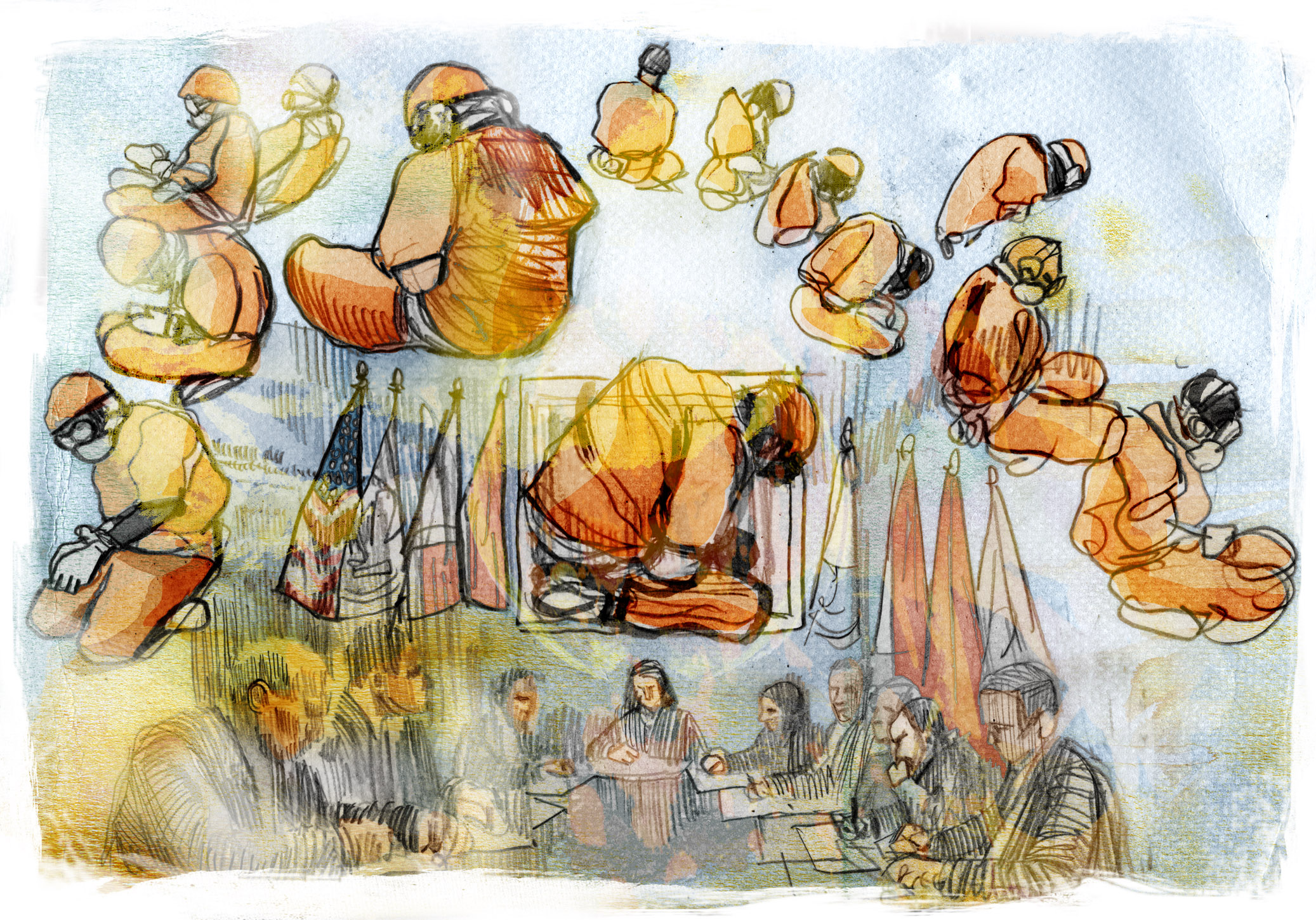By Anne-Laure Pineau and Sophia Tardy-Joubert. This article is part of a series on sexual violence in armed conflicts, commissioned and published by Zero Impunity.
A late warm spell warmed Washington in fall 2016. Pumpkins sat squarely on porch stoops and Halloween skeletons dangled from red-tinted trees in the yards of Georgetown, an upscale neighborhood in the US capital city. John Rizzo, the former Deputy Counsel of the CIA, is spending a peaceful retirement there. Each morning, he takes care to match his socks to his polo shirt before going for a stroll down the pretty streets lined with small brick homes.
Fourteen years ago, this snowy-haired dandy was part of a small group of people who, in the secrecy of their meeting point in the CIA’s headquarters, decided to legalize a new method of interrogation. These enhanced techniques were supposed to “break the resistance” of prisoners captured in the War on Terror. The decision to use these techniques in Guantanamo, Abu Ghraib and other secret locations would forever change the face of the United States. It would open the door to the use of multiple forms of torture that would cause prisoners physical, psychological… and sexual trauma.
Rizzo was relaxed and affable when Zero Impunity met with him on October 20, 2016. “I am sure I could have stopped it, I could have even before it started”, he said, half-smiling, referring to the decision to use of methods of enhanced interrogation.
But he didn’t stop it and he assumes responsibility for that decision. He says his decision reflected the situation that the country was in at the time. “In the aftermath of 9/11, the universal opinion inside the States was to keep this from happening again,” Rizzo said.
To understand the birth of these “enhanced interrogation techniques”– the CIA’s clinical official terminology– you must go back to the trauma that the United States experienced at the dawn of the new millennium: the September 11 attacks.
Intelligence officers had failed; they hadn’t been able to thwart the attacks. That made them ready to do anything to make sure that the nightmare didn’t happen again. They were even ready to change the rules of war. On September 17, six days after the attacks, the presidential cabinet gave the CIA full power to arrest potential terrorists and to create a new interrogation system. Rizzo remembers it like it was yesterday.
“Usually, when you go to a country, you steal something, you kill somebody, but then you’re out. But this was not a single activity; it was a program that was not going to end,” he said. “To keep that with such a small amount of people that was a mistake”.
On the ground, the hunt for terrorists was far from simple. Agents labored to figure out the identities of the masterminds behind the September 11 attacks. After several long months, the CIA made the first capture of a “high-value detainee” in Pakistan in March 2002. Abu Zubaydah, a Saudi national, was about 30 years old at the time of his arrest. Suspected of being one of the orchestrators of the 9/11 attacks, Zubaydah was also thought to have close ties to Osama Bin Laden.

“The big motivator was if anyone would know about a new plan, it would be Zubaydah – because he was involved in getting passports to the original hijackers, so he would have been in that loop,” Rizzo said. “But in fairness, he wasn’t quite [as big a] fish as we first thought he was.” During interrogations, Zubaydah met questions with silence. “The CIA people who interrogated him were convinced he was holding back,” Rizzo said. “So we had to get him to talk”.
Faced with a detainee whom they considered uncooperative, the CIA hired two psychological consultants, James Mitchell and Bruce Jessen, to design what would be called the “enhanced interrogation techniques” program. These two men had never attended a real interrogation. And, so, they improvised, claiming to base their program on the principles of cognitive behavioral therapy. In reality, what they came up with was an almost line-by-line adaptation of the Survival Evasion, Resistance and Escape military training program. The “SERE” program, created after the Korean War, was a guide to prepare soldiers and civilians in case they were captured by the North Korean secret service and tortured.
Mitchell and Jessen used the North Korean torture techniques described in that report to create the “enhanced interrogation techniques,” which aimed to “make things uncomfortable for [the detainee]” so as to “break him down and break down his arrogance”, according to Rizzo.
The list of techniques that the two psychologists proposed to Rizzo included “forced nudity”, “taking advantage of the detainees fears”, “stress positions” and “interrogations of up to 20 hours”.
Seeing the list, the lawyer panicked. “My first reaction was: no! We can’t do this! This stuff is brutal!” Rizzo said.
He was well aware that these techniques skirted the brink of legality. The United States had signed the Geneva Conventions on the treatment of POWs as well as the UN Convention against Torture. Still, according to Rizzo, these were but “pesky little international obligations”, as he wrote at the time in an email addressed to a colleague at the CIA. And so, he decided to disregard these obligations. Instead, he fell into line behind the so-called experts in psychology and supported their recommendations.
“It was better that than risking the possibility of a new terrorist attack and seeing hundreds or thousands of innocent Americans killed,” he says today. Zubaydah would become the CIA’s “lab rat”. He’d be locked naked in a box the size of a coffin, forced to undergo rectal feeding, kept naked for long periods and waterboarded a total of 83 times. Rizzo knew that with these techniques, they were crossing a red line. “It’s going to come out someday [and] we’re going to be screwed”, he said he thought at the time.
Rizzo was careful to link the White House to his decision. He said these new techniques were the subject of daily meetings, held in the office of the director of the CIA and attended by a few select members of government. President Bush was noticeably absent. They discussed the techniques one by one. According to Rizzo, National Security Advisor Condoleezza Rice was uncomfortable with the idea of forcibly stripping detainees during interrogations. Did she understand that this kind of technique would undoubtedly lead to serious crimes? Maybe, but even if she did, she didn’t put her foot down.
“Even with the objections they had– Rice with forced nudity and Powell with sleep deprivation– they just said ‘I’m not comfortable with it’”, Rizzo said. “They never said we shouldn’t do it.”
The small committee approved the techniques proposed by the psychologists. In July 2002, Condoleezza Rice, in the name of the US government, gave the CIA a green light. “Forced nudity” would be used on individuals who the CIA suspected of having links, close or removed, with the nebulous Al Qaeda. The technique would be inscribed in memos circulated throughout the Department of Defense. Both “forced nudity” as well as “taking advantage of the detainees fears” would lead to what can be called “sexual torture.”
None of the people previously cited accepted Zero Impunity’s request for interviews. The CIA, through spokesman Ryan Trapani, said that the Agency had nothing to “share” on the topic and wished us “good luck”.
The Department of Defense also decided to dodge the issue. Defense Department spokesperson Lieutenant Colonel Valerie D. Henderson wrote, in an email on December 30, 2016, that “The Department of Defense is committed to treating all detainees humanely, and in accordance with all applicable domestic law and policy and international obligations, including Common Article 3 of the Geneva Conventions.” She added that the “DoD takes allegations of detainee abuse very seriously. DoD investigates credible abuse allegations and takes appropriate action, which could include criminal prosecution”.
Back in the White House, most of the senior officials had no idea that, just a few miles away, the CIA was working to get methods of torture legalized within a democracy. Lawrence Wilkerson believed that he was in on the political secrets of his country– and with good reason. This stately Vietnam veteran served as Chief of Staff to Secretary of State Colin Powell under the Bush administration. Wilkerson spoke with Zero Impunity on October 20, 2016, at a Starbucks in a mall on the outskirts of Washington. Gentlemanly and courteous, Wilkerson wore small, round glasses and an elegant tweed jacket adorned with a pin shaped like an American eagle.
“We essentially found out on the television that we had lost the debate [to uphold the Geneva Convention]”, he said, still angry. Wilkerson knows that he had been sidelined. In his mind, the whole affair was a “coup d’état” organized by Vice President Dick Cheney.
“This was a decision-making coup, but it happened all the time with the vice president. This wasn’t something we weren’t used to,” Wilkerson said. “From 2001 to 2005, it was routine for the vice president to make a decision himself and then go to the Oval Office to convince the president to back him. Then, he’d come back and present it to the rest of the cabinet”.
When Wilkerson learned that the CIA had used the SERE program to develop its torture techniques, he lost his temper. “I went to Powell, saying ‘you’re a military guy, I’m a military guy. Can you believe these stupid a–holes at the Secretary of Defense’s level fell for this s–t? It’s incredible.’” More than anything else, Wilkerson feared that the CIA’s techniques would spread to the army. A military man himself, and son of a military man, Wilkerson knows soldiers well. He also knows what they are capable of when given free rein.
The exact scenario that he feared came about quickly. Starting in fall 2002, the army started using the exceptional techniques created by the CIA.
The commander of the Joint Task Force section assigned to Guantanamo, General Michael Dunlavey (who was replaced by General Miller on November 9, 2002), wanted to break down the defenses of a particularly difficult detainee, detainee 63. This 22-year-old Saudi citizen named Mohammed al-Qahtani was captured in Afghanistan in November 2001 and had spent long months waiting in a cell in Guantanamo. General Dunlavey petitioned Secretary of Defense Donald Rumsfeld for permission to use “enhanced interrogation techniques” on detainee 63. Rumsfeld agreed.
For 49 days straight, al-Qahtani was interrogated for 20 hours a day. During this time, he was also regularly sexually assaulted. Army interrogators pasted pornographic pictures on al-Qahtani’s naked body, threatened to rape his mother and made him walk around wearing a women’s bra, according to reports that have since been declassified.

In April 2003, Rumsfeld would go even further to give soldiers free reign. In a memorandum explaining how these “counter-resistance techniques in the War of Terrorism” should be applied, Rumsfeld wrote “It is important that interrogators be provided reasonable latitude to vary techniques depending on the detainee’s culture, strengths, weaknesses and environment… as well as the urgency of obtaining information that the detainee is known to have.” Humiliation, then, could go much farther than forced nudity. Soldiers wouldn’t hesitate to use this “blank check”.
The sky weighs heavily on the urban landscape of the French city of Lyon, where autumn is slowly taking hold. Vénissieux’s looming apartment blocks, patterned with thousands of windows, are visible from the highway. Nizar Sassi calls this gritty suburb on the southern outskirts of Lyon home. Zero Impunity met with Sassi in a Brioche Dorée, a French chain bakery, tucked into a mostly-empty mall.“These aren’t things that you can talk about easily on the phone,” Sassi warned during an earlier phone conversation. Sassi– now 37 and a father of three– works as an elevator repairman. His current peaceful life and his outward appearance– Sassi has a sleek actor’s physique– offer no sign of his tumultuous past.
Only his deep gaze might give window to this past: Sassi was one of six “Guantanamo Frenchmen”. He wanted to speak to Zero Impunity about the sexual abuse that went on in the Cuban prison– which, for him, was “the worst” of what he experienced there. This marked the first time he has talked about the subject in depth. He wants to break the taboo.
Sassi was 22 in 2001 when he left France for Pakistan. Under the influence of an older boy from his neighborhood, Sassi and the friend he was traveling with– Mourad Benchellali– ended up in a Bin Laden training camp over the border in Afghanistan. Sassi was in Pakistan, trying to return to France when he was captured by Pakistani soldiers. They handed him over to the Americans and Sassi was moved to a US-run camp in Kandahar, Afghanistan.

“We were the first to be caught. We were hit and mistreated, but the worst was the rape”, Sassi said. After being beaten, Sassi and about 30 other detainees were taken into a tent. “We were standing in a single file line,” he said. “They pulled down our pants and raped us, one by one. I don’t know what they put up our bums, but it was extremely brutal. It tore me up. Then, they sprayed us with a high-pressure hose and threw us on top of each other in a mountain of naked men. The whole time, they were taking pictures of us.”
Zero Impunity also met with Sassi’s friend, Mourad Benchellali, in Paris on September 11, 2016. Though Benchellali often speaks publicly about his ordeal, he declined to give details about the sexual abuse that he experienced personally. “You remember the photos of Abu Ghraib with the pyramids of detainees? It was the same thing. It went above and beyond humiliation,” he said.
In January 2002, both Sassi and Benchellali were transferred from Kandahar to Guantanamo. Sassi would stay there until his release in summer 2004. During the time that he was imprisoned there, he says he and the other detainees were subjected to repeated and violent rectal inspections, under the pretext of security.
“Each time that they inspected our private parts, they took a malicious pleasure in palpating, insisting,” Sassi said. “The punches? You forget about them eventually. But that feeling… that doesn’t go away.”
At neighboring tables in the Brioche Dorée in Vénissieux, families chat over steaming cups of hot chocolate. Sassi, slightly uncomfortable, whispers about what happened to him in Guantanamo. Sometimes, words escape him and he resorts to gestures. He lifts up three fingers to represent the hand of a soldier who penetrated him without warning. According to the four former prisoners who spoke to Zero Impunity, these abusive body cavity searches were conducted under the watchful eye of doctors. “They didn’t touch us. But they stood off to the side with the high-ranking officers while the soldiers raped us. And they watched,” Sassi remembers.
In the CIA’s secret prisons, doctors went farther than just observation. They also participated in the use of so-called medical procedures to try and change the behavior of the “big fish” that they supposedly had in their nets. Protected by the classified nature of army reports, the names of these practitioners remain secret even today.
Suspected of financing the September 11 attacks, Mustafa al-Hawsawi has been shuffled between various secret CIA prisons and Guantanamo for fourteen years. He is currently being held in Guantanamo. In October 2016, he had a rectal reconstructive operation, on the United States’ dime.
Al-Hawsawi had suffered from chronic hemorrhoids, an anal fissure and symptomatic rectal prolapse for more than ten years leading up to the operation.
His lawyer, Walter Ruiz, said that al-Hawsawi had to ‘reinsert parts of his anus back into his cavity’ after having a bowel movement. This was the consequence of “rectal re-feeding” and “rectal rehydration” carried out on al-Hawsawi while he was detained in Guantanamo. “The Senate Intelligence Committee Report on CIA Torture underlined the fact that they used “the largest tubes” available for these procedures,” Ruiz said. “It was sodomy. These doctors who inserted the tubes by force in these people’s anuses still practice medicine.”
“[Rectal feeding] is not medically justified unless people are in a vegetative state or [have] suffered intestine loss. On a medical basis, there’s no need to do that,” said Sarah Dougherty at “Physicians for Human Rights”, an organization of doctors and scientists that brings medical expertise to organizations that document crimes against humanity. Dougherty is an expert on the question of American torture.
“It’s one of the biggest scandals in American medical history,” she said. “There have been disappointingly few attempts by the professional medical community to seek accountability”. In Guantanamo, the accounts of sexual assault were passed from cell to cell as the detainees whiled away long, dull hours. The stories told by the Saudis, the Yemenis and the Algerians were the worst.
“They used a lot of sexual humiliation techniques on men from the Middle East,” former Guantanamo detainee Sassi said. “These men had never had contact with a Western woman, and even less so with a naked woman pretending to give herself to him. They were traumatized. They were more afraid of that than of being hit.”
Were there women who undressed in the interrogation rooms in Guantanamo Bay? Mourad Benchellali recounted how a naked woman remained in the room during the entirety of one of his interrogations. She stood there silently, leaning up against the wall. According to internal army reports on the prisons in Guantanamo and Abu Ghraib, these women were soldiers. The Schmidt report includes information about an intelligence officer who admitted to asking one of his subordinates to buy cheap perfume, to put it on her hands and to rub them on a detainee to break his resistance.
In other cases, it was female soldiers themselves who– under pressure to get results– decided to transform their bodies into weapons of humiliation against the detainees.
In his book, Inside the Wire, former army translator Erik Saar told the story of an interrogation that he carried out with a female soldier named Brooke. Brooke suspected that the detainee was drawing the strength to resist from prayer. “Erik, I’m going to work on making him feel like he can’t pray”, she said. During the interrogation, she tried her strategy.
“Do you like these big American tits, Fareek?” she said. “I can see you are starting to get hard. How do you think Allah feels about that?” At the recommendation of a guard, the young woman went so far as to make the detainee, who had already started talking, believe that she was smearing menstrual blood on him. Erik Saar remembers that his colleague was shocked by her own behavior.
“Brooke looked at me and began to cry. She was too exhausted, but wholly frustrated as well. I just looked at her. I knew she hadn’t enjoyed this. She had done what she thought was the best to get the information her bosses were asking for.”
The Criminal Investigation Task Force (CITF) was created by the Department of Defense to investigate detainees in the War on Terror. Mark Fallon, the CITF’s deputy commander, was in Guantanamo to gather enough information on the detainees to try them. Zero Impunity met with Fallon on October 19, 2016. Fallon, a retiree with laughing eyes, is still haunted by the time he spent at Guantanamo. He was one of only a handful of high-ranking soldiers who tried to sound the alarm about what was happening in Guantanamo, to denounce these “shameful and deplorable” acts.
Fallon is known for his extensive experience as an interrogator while serving as a special agent. This man of austere appearance spent years blending into criminal networks, disguising himself at times as a drug dealer, an elephant poacher and an arms trafficker. Fallon began investigating Al Qaeda in the 1990s, so it was logical for the American authorities to call on him when they decided to set up an intelligence service on the prisoners detained in Guantanamo.
Commander Fallon supervised a team made up of 230 people. His staff worked alongside soldiers under General Geoffrey D. Miller, the other military commander present in Guantanamo. Fallon and Miller opposed each other in every way and the two officers would soon become enemies. Fallon had no respect for Miller, a general trained in field artillery, but who had no military intelligence experience. Miller, for his part, got exasperated by what he perceived as Fallon’s leniency toward the detainees.
“You [could] see [Miller’s troops] wanted to waterboard [the detainees],” Fallon said. “They’d strip them naked and put water on them. It was embarrassing and amateurish. I was very concerned because [Miller] was an artillery officer who knew nothing about intelligence, about interrogation…”
The men under Fallon soon started to report the worrying practices that were taking place under the orders of General Miller. Extremely shocked, Fallon contacted the General Counsel of the Navy, the institution responsible for the Guantanamo Bay Naval Base. He shared the email that he sent on October 28, 2002 with Zero Impunity.
“We need to ensure seniors at OGC [Editor’s note: Alberto Mora] are aware of the 170 [the section directed by General Miller] strategies and how it might impact CITF and Commissions…” He went on to cite specific comments, allegedly made by Lieutenant Diane Beaver, about the techniques. “Comments like… if the detainee dies, ‘you’re doing it wrong’ and… ‘medical personnel should be present to treat any possible accidents’ seems to stretch beyond the bounds of legal propriety,” he wrote. “Someone needs to be considering how history will look back at this.”
Despite the warnings written by Fallon, in September 2003, General Miller was sent to Iraq to “Guantanamize” Abu Ghraib prison, or, in other words, to import the interrogation methods used in Cuba.
“When I saw he was going to Iraq, I sent somebody with him from the CIDF to try to tell everyone else not to do this,” Fallon said. “I was so afraid that it would spread like a malevolent cancer. When I found out he was going to go, I knew there would be abuses.”
Less than a year later, in April 2004, Fallon would learn that his nightmare had become a reality when photos documenting abuse in the Iraqi prison Abu Ghraib were shared around the world. Photos printed on glossy paper showed naked prisoners piled into pyramids. Others showed detainees forced to masturbate in front of laughing soldiers. Another showed naked detainees being led on a leash by women in uniform. The entire United States was shocked. Secretary of Defense Donald Rumsfeld quickly blamed these abuses on a few isolated soldiers, a few “bad apples”.

After the Abu Ghraib scandal, most of the soldiers who were recognizable in the photos–as well as the commander of the prison, Janis Karpinski– were sanctioned. They were the only ones accused. “Janis Karpinski said that she wasn’t guilty, and I agree with her. She was a scapegoat”, said Lawrence Wilkerson, Colin Powell’s former right-hand man. “However, other people, starting with Dick Cheney, should be sued for war crimes. At the very least, they should have been dismissed.”
But today, these Washington bureaucrats are all doing very well. And there’s little chance of that changing. During the 2016 American presidential campaign, Republican candidate Donald Trump promised to “load [Guantanamo] up with some bad dudes…” and to re-establish the practice of waterboarding. While the president-elect is known for changing his mind, it remains extremely likely that he’ll chose, like his predecessor, Barack Obama to look towards the future, without recognizing the crimes committed by the United States, a nation that, for a certain time, used sexual abuse as a weapon against terrorism.
Nizar Sassi, who is still deeply scarred by his time in Guantanamo, finishes drinking his strong coffee at Brioche Dorée. Like the five other former Guantanamo detainees in France, Sassi is part of a class suit, seeking recognition for the torture and rape that he underwent. However, they have little chance of succeeding.
The French justice system served General Miller with a summons in March 2016. The man, once nicknamed “the king of Guantanamo”, never responded– he had no legal obligation to do so. Like many others, Sassi has little remaining hope in humanity.
“I’m putting my faith in the final judgement”, he says. “Allah’s judgement.”
To follow up and take action: become part of the Zero Impunity movement.





